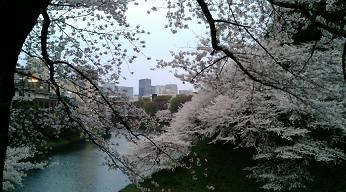When the cherry trees blossom, we say that spring is in full bloom, which compares spring to a flower that blossoms extravagantly at the height of its beauty. Of all the flowers that bloom in spring, Japanese people think of cherry blossoms first. For people of all walks of life, cherry blossoms are the flowers that come once year with spring.
In most of Japan, the beginning of the new school year coincides with the cherry blossoms in April although there is a slight divergence in Hokkaido and Okinawa. Cherry blossoms remind me of the entrance ceremony in elementary school when I was a first-grader. It is somewhat embarrassing to recall now, but I am not sure why I was so frightened that I couldn't even enter the school grounds. I remember my mother pulling me along by the hand as I passed through the school gate, crying. I can see in my mind's eye the young cherry tree that was quietly blossoming beside the school gate at the time, and I recall giving it a glance. When I look back on my life now, that memory sometimes comes back to me. It seems there is no way of telling what a child's future will be.
After entering the 1930s, there was a period of war made up of "incidents" leading up to World War II. During that time, I don't remember merrily viewing cherry blossoms with food and drink as we do today. But, the cherry blossoms faithfully marked the start of spring each year.
I spent the latter days of the war in a naval academy and two springs on Etajima Island in the Inland Sea. The school on Etajima Island had many cherry trees which blossomed brilliantly in April. In spring 1944, we could still afford to appreciate the cherry blossoms, but the spring of 1945 was a different story altogether. The situation became increasingly dire for Japan with the Battle of Iwojima in February and the American assault on Okinawa at the end of March. Grumman planes took off from aircraft carriers and flew over the skies of Etajima as American troops approached the shores of the main island of Japan. These planes descended quickly to fire on us as we ran to dive into the air raid shelters in the mountains. They were so close that we could see the pilot's face when he turned the plane around after completing the attack. The cherry trees were blossoming in the mountains then, too.
As for the cherry blossoms after the war was finally over and peace came, these were something special. My first encounter with cherry blossoms in the postwar period was at the Faculty of Liberal Arts at the University of Tokyo. The campus is full of cherry trees and they were in full bloom that April. I lived in Komaba for about three years after the war because the prewar education system with three-year high school curriculum was still in effect and students had to live in the dormitories. As we viewed the cherry blossoms, we drank beer, sang dormitory songs and enjoyed our youth, ever grateful for the peace that had come. Every spring, those of us who boarded in the same room still get together to enjoy the cherry blossoms. Unfortunately, this year, I wasn't able to coordinate my schedule and join.
For some reason, the cherry blossoms this year weighed on my mind. It might have been because the TV and newspapers are always reporting on how the cherry blossom season starts earlier each year due to global warming. When I took the expressway from Setagaya to Kanda three times during a week, the cherry trees caught my attention as they never had before. Entering the tunnel to Kasumigaseki and exiting at Daikancho, it suddenly gets light. The cherry trees inside the Imperial Palace moat leap into view on the right and left together with those of Chidorigafuchi on the left. Then right away, there's another short tunnel that leads to Kanda and not much time to look at the cherry blossoms.
According to projections this year, the cherry trees in Tokyo were supposed to be in full bloom on March 21. Due to the cold February-like weather that continued for some time, the cherry trees around the Imperial Palace moat and at Chidorigafuchi took their time opening. The bare cherry trees were a sad sight to see. As March gave way to April, it began to get warm. The trees suddenly began to blossom, and before I knew it, they were in full bloom. Suddenly it was the height of spring. A week later, the blossoms began to fall, fluttering down in a blizzard of flower petals. Even so, they were in full bloom for longer than usual.
Despite global warming, I don't think that it will get to the point that we will never be able to enjoy cherry blossoms, but we can be sure that many things will change. For every degree the temperature rises, the northern limit of vegetation moves 180 to 200 kilometers northward. This means that the "cherry blossom front" that heralds the start of the season will progressively move northward earlier, too. Rather than the timing of the cherry blossom season, the greater concern is the threat to the ecology of the cherry trees posed by such abnormal weather phenomena as heat waves, torrential rains, and drought that are caused by global warming. Thinking that one day we may no longer be able to view cherry blossoms in a carefree spirit, I am already beginning to get a little worried about the cherry blossoms next year.















